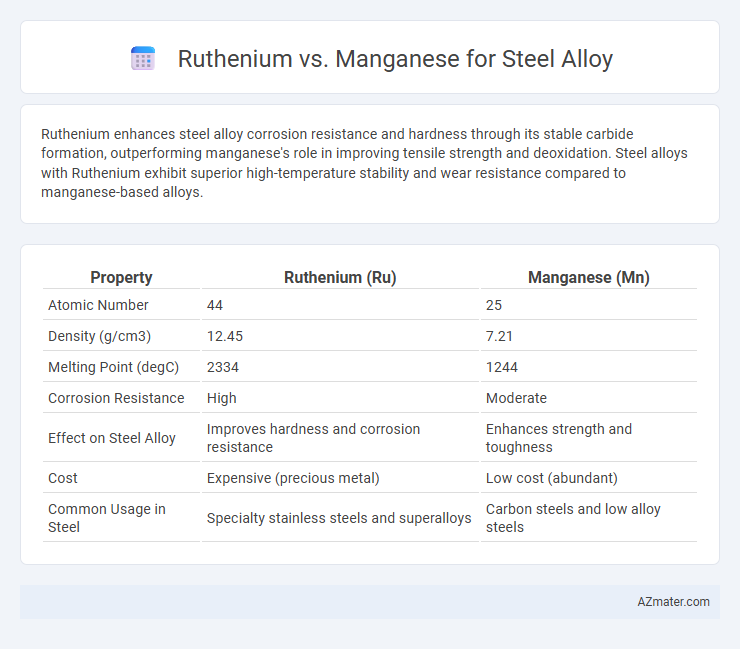Ruthenium enhances steel alloy corrosion resistance and hardness through its stable carbide formation, outperforming manganese's role in improving tensile strength and deoxidation. Steel alloys with Ruthenium exhibit superior high-temperature stability and wear resistance compared to manganese-based alloys.
Table of Comparison
| Property | Ruthenium (Ru) | Manganese (Mn) |
|---|---|---|
| Atomic Number | 44 | 25 |
| Density (g/cm3) | 12.45 | 7.21 |
| Melting Point (degC) | 2334 | 1244 |
| Corrosion Resistance | High | Moderate |
| Effect on Steel Alloy | Improves hardness and corrosion resistance | Enhances strength and toughness |
| Cost | Expensive (precious metal) | Low cost (abundant) |
| Common Usage in Steel | Specialty stainless steels and superalloys | Carbon steels and low alloy steels |
Introduction to Steel Alloying Elements
Ruthenium and Manganese play distinct roles as alloying elements in steel production, with Manganese primarily enhancing hardness, strength, and resistance to wear by removing oxygen and sulfur impurities. Ruthenium, a rare platinum-group metal, contributes to improved corrosion resistance and mechanical stability in high-performance steel alloys. The selective addition of these elements tailors steel properties for specific industrial applications, optimizing both durability and functionality.
Overview of Ruthenium in Steel Alloys
Ruthenium enhances steel alloys by significantly improving hardness, wear resistance, and corrosion resistance compared to manganese, which primarily contributes to toughness and ductility. Its addition at low concentrations refines microstructure and stabilizes carbides, leading to superior mechanical properties in high-performance steel applications. Ruthenium's rarity and high melting point make it especially valuable in specialized steels used in aerospace, automotive, and cutting tools.
Properties of Manganese in Steel Production
Manganese significantly enhances steel's strength, hardness, and wear resistance by acting as a deoxidizer and sulfur fixer during the smelting process. Its presence improves hot working properties and helps prevent brittleness, making manganese essential in producing durable and high-performance steel alloys. Compared to ruthenium, manganese is more widely used due to its cost-effectiveness and ability to improve mechanical properties in large-scale steel production.
Comparative Mechanical Strength: Ruthenium vs Manganese
Ruthenium significantly enhances the mechanical strength of steel alloys by improving hardness and wear resistance due to its ability to form stable carbides and inhibit grain growth. Manganese contributes to steel toughness and impact resistance but generally offers lower overall strength compared to ruthenium-enriched alloys. Steel alloys with ruthenium exhibit superior tensile strength and fatigue resistance, making them more suitable for high-stress applications than manganese-containing steels.
Corrosion Resistance: A Key Differentiator
Ruthenium significantly enhances steel alloy corrosion resistance by forming a stable, protective oxide layer that prevents deterioration in harsh environments. Manganese, while improving strength and toughness, offers limited corrosion resistance compared to ruthenium, making it less effective for applications exposed to aggressive chemicals or marine conditions. The superior corrosion resistance of ruthenium-infused steel alloys is a key factor for industries such as aerospace and chemical processing that demand long-lasting, durable materials.
Impact on Steel Hardness and Toughness
Ruthenium significantly enhances steel hardness by refining grain structure and promoting carbide formation, leading to improved wear resistance and strength. Manganese primarily increases toughness by improving ductility and impact resistance while also contributing to hardness through solid solution strengthening. The balance of ruthenium and manganese in steel alloys optimizes both hardness and toughness, making the material suitable for demanding structural and industrial applications.
Cost and Availability in Industry
Ruthenium is significantly more expensive and less abundant than manganese, making it a cost-prohibitive option for large-scale steel alloy production despite its beneficial properties such as corrosion resistance and hardness. Manganese remains the preferred choice in the steel industry due to its widespread availability, lower cost, and essential role in enhancing steel's strength and wear resistance. The availability of manganese mines globally, particularly in countries like South Africa, Australia, and China, ensures a stable supply chain, whereas ruthenium's rarity and higher market price limit its industrial adoption.
Environmental and Safety Considerations
Ruthenium in steel alloys offers enhanced corrosion resistance and durability, reducing the frequency of steel replacement and thereby minimizing environmental impact through resource conservation. Manganese, while essential for improving steel toughness and strength, poses health risks in dust and fume form during manufacturing, necessitating strict occupational safety measures. The environmental footprint of manganese extraction and handling often exceeds that of ruthenium, which, despite its higher cost, supports longer-lasting steel products with fewer emissions over the lifecycle.
Applications in Advanced Steel Technologies
Ruthenium enhances steel alloys by improving corrosion resistance and hardness, making it ideal for high-performance applications in aerospace and medical devices. Manganese plays a critical role in steel by increasing toughness and wear resistance, mainly used in construction and automotive industries. The combination of ruthenium and manganese in advanced steel technologies allows for tailored mechanical properties and enhanced durability in extreme environments.
Future Prospects: Ruthenium vs Manganese in Steel Alloys
Ruthenium's exceptional corrosion resistance and catalytic properties suggest a growing role in high-performance steel alloys for advanced industrial applications. Manganese remains essential for improving steel toughness and deoxidation but faces limitations in wear resistance compared to ruthenium-enhanced alloys. Future steel formulations are likely to prioritize ruthenium additions to achieve superior durability and environmental resilience in critical sectors such as aerospace and energy.

Infographic: Ruthenium vs Manganese for Steel Alloy
 azmater.com
azmater.com